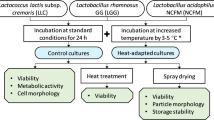Abstract
Optimal lyophilization process was developed for manufacturing the dried product ofLactobacillus acidophilus with high cell viability. Three major factors, freezing rate, specific surface area of samples, and stabilizer type and their synergy were shown to play a crucial role in the development of an effective lyophilization process. Finally we found an optimal combination among three process parameters mentioned above: an exceptionally high cell survival percentage of 90% was achieved using the 8.28 cm−1 specific surface area of samples, slow freezing rate, and a stabilizer composition of 4% skim milk+1% glycerol +0.1% calcium chloride.
Similar content being viewed by others
References
Sarra, P. G. and F. Dellaglio (1984) Colonization of a human intestine by four different genotypes ofLactobacillus acidophilus.Microbiologica 7: 331–339.
Onishi, N. and A. Yamashiro (1991)Eur. Patent 0416 892.
Moore, W. E. C. and L. H. Moore (1995) Intestinal flora of populations that have a high risk of colon cancer.Appl. Environ. Microbiol. 61: 3202–3207.
Gangjee, A. A. P., A. Vidwans, S. F. Vasudevan, R. L. Queener, V. Kisliuk, R. M. Cody, N. Li, J. R. Galitsky, and L. S. Pangborn (1998) Structurebased design and synthesis of lipophilic 2,4-diamino-6-substituted quinazolines and their evaluation as inhibitors of dihydrofolate reductases and potential antitumor agents.J. Med. Chem. 41: 3426–3434.
Watanabe, T. (1996) Suppressive effects of Lactobacillus casel cells, a bacterial immumostimulant, on the incidence of spontaneous thymic lymphoma in AKR mice.Cancer Immunol. Immunother. 42: 285–290.
Datta, R., S. P. Tsai, P. Bonsignore, S. H. Moon, and J. R. Frank (1995) Technological and economic potential of poly (lactic acid) and lactic acid derivatives.FEMS Microbiol. Rev. 16: 221–231.
Tsai, S. P. and S. H. Moon (1998) An integrated bioconversion process for production of L-lactic acid from starchy potato feedstocks.Appl. Biochem. Biotechnol. 70/72: 310–317.
Ohleyer, E., H. W. Balanche, and C. R. Wilke (1985) Continuous production of lactic acid in a cell recycle reactor.Appl. Biochem. Biotechnol. 11: 317–331.
De Man, J. C., M. Rogosa, and M. E. Sharpe (1960) A medium for the cultivation of Lactobacillii.J. Appl. Bact. 23: 458–464.
Kang, M. H. and J. Lee (1998) Continuous cultivation of a human intestinal microflora at high cell concentration via controlled culture recycle.Biotechnol. Lett. 20: 295–299.
Johnson, J. A. C. and M. R. Etzel (1995) Properties ofLactobacillus heleveticus CNRZ-32 attenuated by spray-drying, freeze-drying, or freezing.J. Dairy Sci. 78: 761–768.
De valdez, G. F., G. Martos, P. Taranto, G. L. Lorca, G. Oliver, and A. P. de Ruiz Holgado (1997) Influence of bile on β-galactosidase activity and cell viability ofLactobacillus reuteri when subjected to freeze-drying.J. Dairy Sci. 80: 1955–1958.
Desmons, S., H. Krhous, P. Evrard, and P. Thonart (1998) Improvement of lactic cell production.Appl. Biochem. Biotechnol. 70/72: 513–526.
Wright, C. T. and T. R. Klaenhammer (1983) Survival ofLactobacillus bulgaricus during freezing and freeze-drying after growth in the presence of calcium.J. Food Sci. 48: 773–777.
Pikal, M. J. and S. Shah (1990) The cake collapse temperature in freeze drying; dependence on measurement methodology and rate of water removal from the glassy phase.Int. J. Pharm. 62: 165–186.
De Valdez, G. F., G. S. de Giori, A. A. P. de Ruiz Holgado, and G. Oliver (1983) Protective effect of adonitol on lactic acid bacteria subjected to freezedrying.Appl. Environ. Microbiol. 45: 302–304.
De Valdez, G. F., G. S. de Giori, A. A. P. de Ruiz Holgado, and G. Oliver (1983) Comparative study of the efficiency of some additives in protecting lactic acid bacteria against freeze-drying.Cryobiology 20: 560–566.
Tsvetkov, T. and R. Brankova (1983) Viability of micrococci and lactobacilli upon freezing and freeze-drying in the presence of different cryoprotectants.Cryobiology 20: 318–323.
Maeda, T., T. Terada, and Y. Tsutsumi (1989) The rate of glycerol and DMSO on the freezing of spermatozoa.Cryo-Lett. 10: 393–400.
Author information
Authors and Affiliations
Corresponding author
Rights and permissions
About this article
Cite this article
Kang, M.H., Saraswat, V., Lee, J. et al. Production of lyophilized culture ofLactobacillus acidophilus with preserving cell viability. Biotechnol. Bioprocess Eng. 4, 36–40 (1999). https://doi.org/10.1007/BF02931911
Issue Date:
DOI: https://doi.org/10.1007/BF02931911




